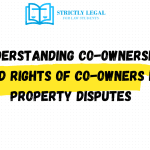Picture this: You claim ownership of a property through sale deeds executed decades ago, but when you approach the court seeking protection through an injunction, your application gets rejected before the opposite party even gets a chance to respond. This isn’t a hypothetical scenario—it’s precisely what transpired in a specific civil suit before the Civil Judge (Junior Division), Siliguri, in a decision that underscores the fundamental principles governing injunction applications in Indian civil law.
On August 11, 2025, the Civil Judge delivered an order that serves as a stark reminder to litigants: the burden of establishing a prima facie case rests squarely on the applicant’s shoulders. The court’s refusal to grant ad-interim injunction, despite allegations of obstruction and threats, illuminates the critical importance of documentary evidence and the credibility of the plaintiff’s narrative in civil disputes.
This comprehensive analysis examines the court’s reasoning, the legal principles applied, and the practical lessons for anyone contemplating an injunction application in property matters.
Factual Matrix of the Dispute
The Plaintiff’s Narrative
The plaintiff approached the court asserting rightful ownership of the suit property, claiming title through a chain of deeds. The chronology of events, as presented by the plaintiff, unfolds as follows:
On July 25, 2025, the defendants allegedly obstructed the plaintiff from entering the suit property, accompanied by verbal abuse and threats of dire consequences. The situation escalated four days later when, on July 29, 2025, at approximately 9:00 AM, the defendants, allegedly accompanied by antisocial elements, attempted to forcibly grab the suit property.
Subsequently, on July 30, 2025, the plaintiff sought to register a written complaint at Phansidewa Police Station. However, the police station refused to receive the complaint, characterizing the dispute as civil in nature rather than criminal—a determination that would later become significant in understanding the court’s approach.
Documentary Evidence Presented
In support of the injunction application, the plaintiff submitted photocopies of the following documents:
- Certified copy of Deed No. XXXXX/1992
- Certified copy of Deed No. XXXXX/1983
- Khatian (land record)
- FIR dated :XXXXXXX
- General Power of Attorney dated XXX.07.2025
Crucially, while photocopies were filed with the record, the plaintiff produced original documents for scrutiny at the hearing—with one glaring exception: the original chain of deeds remained conspicuously absent; that too without a plausible explanation.
Legal Framework: The Four Pillars of Injunction
Before delving into the court’s analysis, it’s essential to comprehend the jurisprudential foundation upon which injunction applications are evaluated. Indian courts have consistently articulated that an applicant seeking injunctive relief must satisfy four cardinal principles:
Prima Facie Case
The applicant must demonstrate that, based on the materials presented, there exists a strong probability that they will ultimately succeed in the main suit. This doesn’t require proof beyond reasonable doubt but necessitates showing that the claim is not frivolous and has substantial merit worthy of judicial protection.
Balance of Convenience
The court must ascertain whether granting or refusing the injunction would cause greater inconvenience. This involves weighing the hardship the plaintiff would suffer if the injunction is denied against the prejudice the defendant might face if it’s granted.
Irreparable Loss and Injury
The applicant must establish that the injury apprehended is of such nature that it cannot be adequately compensated through monetary damages. The harm must be substantial, imminent, and beyond pecuniary valuation.
Urgency
There must exist an element of immediacy that necessitates the court’s intervention before affording the opposite party an opportunity to respond. This pillar recognizes that certain situations demand swift judicial action to preserve the status quo.
Court’s Meticulous Analysis and Reasoning
The Civil Judge’s order demonstrates a methodical application of established legal principles to the facts presented. Let’s examine the court’s reasoning in detail:
The Suspicious Cloud Over Chain Deeds
The court’s most significant observation concerned the “cloud of suspicion” cast over the chain of deeds. The judgment explicitly states:
“A cloud of suspicion is cast at the intersectionality of the chain Deed No. 3815/1992 and also deed No. 1114/1983 due to non production of the original one and also lack of reason cited by the plaintiff behind the non production of the same.”
This observation is pivotal. In property disputes, the chain of title forms the very foundation of ownership claims. When a plaintiff seeks injunctive relief based on alleged ownership, the court must be satisfied that there exists credible evidence supporting such ownership. The non-production of original deeds, particularly when no explanation is offered for this omission, raises legitimate questions about the authenticity and legal efficacy of the claimed title.
The Temporal Anomaly
The court identified a striking temporal inconsistency in the plaintiff’s narrative that fundamentally undermined credibility. The order notes:
“It is alleged by the plaintiff that the defendants obstructed him for construction of boundary wall. It transpires that the alleged sale deed was executed in the year 1983 whereas plaintiff went for construction of boundary wall in the year 2025.”
This 42-year gap between the execution of the sale deed and the purported attempt to construct a boundary wall raises several uncomfortable questions:
- Why did the plaintiff wait over four decades to assert physical possession?
- What prevented the plaintiff from exercising ownership rights during this extended period?
- Does this delay suggest that the plaintiff’s claim to possession might be fabricated or exaggerated?
The court’s skepticism appears well-founded. In property law, consistent and continuous exercise of ownership rights strengthens one’s claim. Conversely, prolonged inaction, absent reasonable explanation, can cast doubt on the genuineness of the claimed interest.
Failure to Establish Prima Facie Case
Drawing these threads together, the court concluded unequivocally:
“The story put forward by the plaintiff is not found to be reliable. Also non production of original sale deeds fails to create prima facie case in favour of the plaintiff.”
This finding is dispositive. Without establishing a prima facie case—the first and most fundamental pillar of injunctive relief—the application cannot succeed, regardless of how the other factors might be evaluated.
The court further held:
“Plaintiff fails to establish prima facie case which is one of the cardinal principles for granting injunction.”
Preference for Audi Alteram Partem
Having concluded that the prima facie case was not established, the court adopted a judicious approach consistent with natural justice principles:
“Therefore this Court is of the view that opportunity of hearing should be given to the defendants before passing any injunction order.”
This reasoning reflects the principle of audi alteram partem—hear the other side. While ad-interim injunctions can be granted ex parte in urgent situations, the court determined that the weaknesses in the plaintiff’s case warranted affording the defendants an opportunity to contest the allegations before any restraint is imposed upon them.
The Operative Order
The court’s final determination was clear and categorical:
“ORDERED that the instant prayer of ad interim injunction as prayed by the plaintiffs is hereby considered and refused.”
However, recognizing that this was merely an interlocutory application and not the final adjudication of the dispute, the court scheduled the matter for September 9, 2025, for appearance of parties and filing of written statements.
Implications and Legal Principles Established
Documentary Evidence Remains Paramount
This order reinforces a fundamental principle: in property disputes, original documents carry evidentiary weight that certified copies, standing alone, cannot replicate. While certified copies may be admissible under the Indian Evidence Act, 1872, their production doesn’t absolve the party from explaining why original documents are unavailable, particularly when the entire case hinges on establishing title through a chain of deeds.
The concept of property in jurisprudence encompasses not merely theoretical ownership but the ability to substantiate such ownership through credible documentary evidence.
Conduct and Delay Matter
The court’s emphasis on the 42-year delay between deed execution and attempted boundary wall construction highlights that a party’s conduct and historical relationship with the property influence the court’s assessment of credibility. Courts are naturally skeptical of claims that emerge suddenly after prolonged dormancy, absent compelling explanation.
Prima Facie Case Cannot Be Presumed
The order demonstrates that courts will not presume the existence of a prima facie case merely because a plaint has been filed. The burden rests entirely on the applicant to affirmatively establish, through credible evidence and a coherent narrative, that their claim has substantial merit warranting immediate judicial protection.
Police Assessment Signals Civil Nature
An interesting aspect of this case is the Phansidewa Police Station’s refusal to register the complaint, characterizing the matter as civil rather than criminal. This assessment, while not binding on the civil court, provides context—it suggests that even from a law enforcement perspective, the dispute appeared to be one of competing property claims rather than criminal trespass or intimidation.
Understanding the distinction between civil and criminal remedies is crucial for litigants. The administrative law framework provides guidance on when state machinery may intervene versus when disputes must be resolved through civil proceedings.
Natural Justice Prevails Absent Urgency
The court’s decision to afford the defendants an opportunity to be heard before deciding the injunction application reflects a balanced approach. While ad-interim orders serve to protect rights in genuinely urgent situations, courts remain mindful of the principle that no person should be condemned unheard. Where the urgency is questionable or the prima facie case weak, natural justice considerations assume greater importance.
Practical Guidance for Injunction Applicants
Ensure Original Documents Are Available
Before approaching the court, verify that all critical documents—particularly title deeds—are available in original. If originals are genuinely unavailable, prepare a detailed explanation with supporting evidence (such as police complaints regarding lost documents or affidavits explaining their absence).
Maintain Consistent Possession
If claiming ownership, demonstrate consistent exercise of ownership rights. Prolonged inaction can be fatal to your case. Document your possession through tax receipts, utility bills, photographs, witness statements, and other contemporaneous evidence.
Craft a Credible Narrative
Your version of events must be internally consistent and align with objective evidence. Courts scrutinize timelines, conduct, and the sequence of events. Any gaps or inconsistencies will be noticed and can undermine your entire application.
Act Promptly Upon Dispossession
If genuinely dispossessed or obstructed, approach the court immediately. Delay suggests either that the dispossession didn’t occur as claimed or that it wasn’t as serious as portrayed. The doctrine of laches—unreasonable delay—can bar equitable relief. Hence, be it a Civil dispute in Siliguri or anywhere else, it is advisable not to delay approaching the court within time.
Engage Competent Legal Counsel
Property disputes involve complex issues of title, possession, and procedural requirements. The services of experienced advocates who understand both substantive property law and the procedural nuances of injunction applications are invaluable. As emphasized in tips for legal internships, understanding practical litigation skills is essential.
The Road Ahead for the Parties
While the plaintiff’s application for ad-interim injunction has been refused, this is not the end of the litigation. The matter will proceed with the defendants filing their written statements, and the court will eventually adjudicate the substantive dispute regarding ownership and possession of the suit property.
The refusal of ad-interim relief doesn’t prejudge the final outcome. It merely signifies that, at this preliminary stage, the plaintiff has not satisfied the court that immediate protection is warranted. The plaintiff may yet succeed in the main suit if they can establish their title and possession through more comprehensive evidence.
Conversely, the defendants must recognize that this interim victory doesn’t guarantee success in the main proceedings. They will need to advance their own case regarding the property and challenge the plaintiff’s claims substantively.
Key Takeaways
- Original documents are crucial: Non-production of original title deeds without explanation significantly weakens prima facie case in property disputes, making injunctive relief difficult to obtain.
- Temporal consistency matters: Courts scrutinize delays between alleged ownership and attempts to exercise possession rights; unexplained gaps undermine credibility and suggest fabricated claims.
- Prima facie case is non-negotiable: Without establishing a strong probability of ultimate success, injunction applications fail regardless of urgency or claimed irreparable injury.
- Natural justice considerations: Where prima facie case is weak, courts prefer affording defendants opportunity to contest before imposing restraints, reflecting audi alteram partem principle.
- Document your possession continuously: Maintain contemporaneous evidence of ownership exercise through receipts, photographs, and witness statements to strengthen future litigation position.
Frequently Asked Questions
An ad-interim injunction is a temporary court order restraining a party from specific actions until the next hearing. Courts grant such relief when the applicant establishes prima facie case, balance of convenience, irreparable injury, and urgency. The order is typically passed ex parte to preserve status quo in genuinely urgent situations where waiting could cause irreversible harm.
The court refused the injunction primarily because the plaintiff failed to establish a prima facie case. The non-production of original sale deeds without explanation, coupled with the suspicious 42-year gap between deed execution and attempted construction, made the plaintiff’s narrative unreliable. Without satisfying this fundamental requirement, the application could not succeed regardless of threat allegations.
While certified copies are admissible under the Indian Evidence Act, they carry less evidentiary weight than originals, especially in property disputes where title verification is crucial. Courts expect parties to produce original documents or provide satisfactory explanations for their absence. Merely relying on certified copies without explaining why originals are unavailable can raise suspicions about authenticity.
No, the refusal of ad-interim injunction does not prejudge the main case outcome. It simply means that at this preliminary stage, the court was not satisfied that immediate protection was warranted. The plaintiff can still succeed in the substantive suit by presenting more comprehensive evidence establishing ownership and possession rights.
If police characterize your dispute as civil rather than criminal and refuse registration, you should immediately approach the civil court seeking appropriate remedies like injunction or declaration of title. Document the police refusal through written correspondence. In genuinely criminal situations involving cognizable offenses, you may approach higher police authorities or file a private complaint before the Magistrate.
The temporal gap matters significantly because it raises questions about the genuineness of ownership claims. Indian courts expect owners to continuously exercise dominion over their property. Prolonged inaction without reasonable explanation suggests either the ownership claim is doubtful or the urgency for protection is manufactured. This affects both prima facie case assessment and credibility evaluation.
The court has scheduled the matter for September 9, 2025, for appearance of parties and filing of written statements. The defendants will now have opportunity to contest the plaintiff’s claims. The case will proceed through normal civil suit procedure, including evidence recording, arguments, and final judgment on the merits of ownership and possession claims. If the plaintiff is aggrieved by the order of refusal it can prefer an revision against the same before the Jurisidictional High Court.
The four pillars—prima facie case, balance of convenience, irreparable injury, and urgency—constitute the established legal framework for evaluating injunction applications in India. The court emphasized that failure to satisfy even one pillar, particularly prima facie case, can be fatal to the application. These principles ensure that injunctive relief is granted only when genuinely warranted.
Conclusion
The Civil Judge’s order stands as an instructive example of how courts approach injunction applications in property disputes. Rather than mechanically granting relief based on allegations alone, the court conducted a thorough examination of the evidence, scrutinized the plaintiff’s narrative for internal consistency, and applied well-established legal principles to reach a just conclusion.
For law students and practitioners, this case reinforces fundamental lessons: documentary evidence must be pristine, conduct must be consistent with claimed rights, and the burden of establishing prima facie case rests firmly on the applicant. The order also demonstrates judicial wisdom in preferring natural justice over hasty interim orders when urgency is questionable.
As the matter progresses through the trial process, it will be interesting to observe how the parties develop their cases and whether the plaintiff can overcome the initial skepticism through more comprehensive evidence. Regardless of the ultimate outcome, this order serves as a valuable reminder that in civil litigation, careful preparation and credible evidence remain the cornerstones of success.
For those seeking deeper understanding of property law principles, exploring jurisprudential concepts of property and administrative law frameworks can provide valuable additional context. The journey through civil litigation is complex, but with proper guidance and understanding of legal principles, navigating these waters becomes considerably more manageable.

Passionate about using the law to make a difference in people’s lives. An Advocate by profession.




